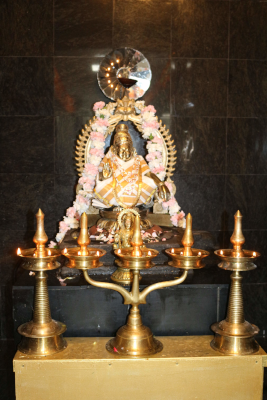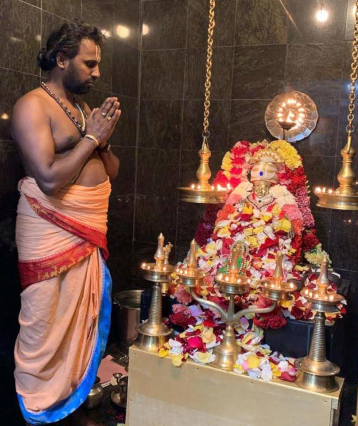Sri Ayyappa Mandala Pooja at Sri Meenakshi Temple
 By Dr. Venugopal Menon
By Dr. Venugopal Menon
PEARLAND: As the very first Shakthi Temple outside India, and the earliest one to install an Ayyappa Sannidhi, Sri Meenakshi temple has also gained the privilege of building the Holy Eighteen Steps – the sacred Pathinettampadi – offering its Sri Sastha devotees a hallowed opportunity to observe all the authentic Pooja traditions of Sabarimala, without even leaving the city of Houston.
For the last 36 years, we have been conducting the most auspicious Mandala Pooja at our temple Ayyappa Sannidhi, with an ever-increasing number of devotes participating in the celebrated annual event. Now they can even undertake the blessed climb on our newly constructed, panchaloha (five metals) made Pathinettampadi.
Perhaps no other concept of Divinity exemplifies the ‘it is all one’ hypothesis of ‘Advaita’ philosophy, that ‘all’ are just an infinitesimal extension of the Ultimate Consciousness, as extolled by the sublime principle of Dharmasastha, the protector of Righteousness, consecrated at the shrine of Sri Ayyappa atop the sacred hills of Sabarimala, in Kerala. Sri Ayyappa is the personification of unity, blending the differences on many planes, many beliefs, many rationales, and many principles into a gigantic acceptance and accommodation of reverence bringing humans together, bonding their minds and blending their devotion to ultimate submission.

Ayyappa or Ayyappan is also referred to as Hariharaputra, Sasthavu, Dharma Sasthavu, or Manikantan. He is the son of Shiva and Vishnu, uniting the Shaivite and Vaishnavite traditions, a celibate yogi God, who can be attained only through penance of self-control, the epitome of Dharma extolling the virtues of rectitude, an incarnation of Buddha, reaching beyond the tenets of Hindu faith, and with his friend a Muslim, accomplishing harmony of religions. Even His devotees are elevated to the level of divinity, calling each other ‘Ayyappa’, transcending the notion of ‘Aham Brahmasmi’, ‘I am the Ultimate Reality’.
Sabarimala Sree Dharma Sastha Temple, dedicated to Lord Ayyappa, is the most famous and prominent among all the Sastha temples in the world, situated on a 3000 feet hilltop in the state of Kerala. Millions of devotees undertake their pilgrimage during the Makaravilakku in the month of January, making it one of the most active pilgrimage sites in the world. Sri Ayyappa of Sabarimala is unique and special, installed, consecrated and invoked as a Naishtika Brahmachari, a celibate forever, in total control of his senses and detached from worldly life, utilizing all his power to a higher level. And in that form, a Naishtika Brahmachari has some peculiarities and requirements to be respected and followed by the devotees who are desirous of visiting Him.

The intensely dedicated devotees observe the obligatory penance, ‘Vritham’ for 41 days, the Mandala Pooja time, starting from the first day of Malayalam month Vrischikam, around mid- November, the day on which Sri Ayyappa was born, and lasting till the end of December. The significance of the Vritham is to observe austerity and abstinence in life, seeking a merger with the Ultimate. The devotee embarks on the sacred mission with the blessings of his elders and the Guruswamy who has attained a status through several visits to Sabarimala. They wear a garland, the mala, made of Tulsi or Rudraksham beads guided by the Guru in the environs of a temple. During the Vritham, the devotees surrender to Sri Ayyappa, being an ascetic, in thoughts, words, and deeds, taking bath early in the morning, praying and offering poojas, following strict sattvic vegetarianism, avoiding sensual pleasures and offering themselves to the service of others. At the conclusion of the 41-day Vritham, under the guidance of the Guru, they perform the Kettunira, preparing the sanctified travel kit termed Irumudi Kettu, a twin pack, the front one, munmudi containing offerings to Sri Ayyappa and the Pinmudi with items for the devotee’s personal needs. The offerings include coconuts filled with ghee, betel leaves and nuts, coins, jaggery, turmeric, camphor, kumkum, vibhhothi and such. At the conclusion of the pooja, each of the Ayyappa pilgrims takes the Irumudi on his head and embarks on the journey to the sacred Sannidhaanam, the Sanctum. On their way, the devotees would be paying their visits to several temples, and reaching the base of the holy hills, dipping in the sacred waters of Pampa river and start their climb of about three miles. They are usually in groups, family and friends led by their Guruswamy and throughout the trip will be devoutly chanting ‘Swamiye Saranam Ayyappa’ and other such praises of the God.
Every Ayyappa devotee, before he reaches the Sanctum Sanctorum, has to lay his footsteps over and climb the sacred 18 steps, the Pathinettampadi. The significance of the ritualistic procedure is a symbolic way of shedding the personal ego, as expressed through the steps. Eighteen is traditionally propitious in Hinduism, as noted from the Vedic age, from the number of chapters in the first Veda, the number of days of the Kurukshetra war, or the chapters in Bhagavad Gita. And the 18 Holy steps in Sabarimala symbolize the five sense organs or Panchenrdriyas, the eight passions, the three natures or Gunas and the last two being Vidya or knowledge and Avidya or ignorance. By climbing the eighteen steps the devotee is getting detached from all the above-mentioned worldly ties and qualifying to attain the divine premise.
Sri Meenakshi Temple inaugurated this year’s Mandala Pooja with the Sapta Sudhi Pooja on November 16th, the daily pooja starting the following day. The day starts with Abhishekam and Malar Nivedyam at 9 am, then the Usha Pooja at 9.45 am, Uccha Pooja at 11.45 am, Deeparadhana and Bhajans at 6.15 pm, Sahasranama Archana at 7.30 pm, with Seeveli (procession) at 8.15 pm and culminating in reciting Harivarasanam, singing the God to His celestial sleep, before closing the Nada for the day. Every Saturday during November and December, there would be Ashtabhishekam. The first Padi Pooja was observed on November 17th and the next one on December 8th evening along with Akhandanamajapam during the whole day and Annadaanam at noon.
A few devotees would be ascending the Pathinettampadi on December 15th and 22nd, along with Ghee Abhishekam Laksharchana and, Deeparadhana followed by the procession on the twenty-second. On December 26th, is Kalabhabhishekam and the following day the Mandala Pooja would culminate in Abharanam (celestial ornaments) procession & Charthu (adorning), Deeparadhana, Pushpabhishekam and Harivarasanam. On the fourteenth of January, the festival of Makaravilakku Pooja on Makar Sankranthi would be performed, coinciding with the major annual celebration at Sabarimala.
Every devotee of MTS and Sri Ayyappa is privileged and invited to participate in the Mandala Pooja observed and celebrated adhering to all the authentic traditions of Sabarimala and performed by our priest Sri Parameswaran. Please sponsor and attend the auspicious poojas with your family and allow the blessings of Sri Sabarimala Ayyappa be showered upon you.
Swamiye Saranam Ayyappa.
